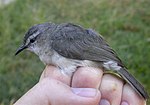Malagasy_warbler
Bernieridae
Family of birds
The tetrakas and allies are a newly validated family of songbirds. They were formally named Bernieridae in 2010. The family currently consists of eleven species (in eight genera) of small forest birds. These birds are all endemic to Madagascar.
In 1934, the monophyly of this group was proposed by Finn Salomonsen but the traditional assignments of these birds were maintained, mistaken by their convergent evolution and the lack of dedicated research. The families to which the Malagasy warblers were formerly assigned—Pycnonotidae (bulbuls) and even more so Timaliidae (Old World babblers) and the Old World warbler—were used as "wastebin taxa", uniting unrelated lineages that were somewhat similar ecologically and morphologically.
It was not until the analysis of mtDNA cytochrome b and 16S rRNA[2][3] as well as nDNA RAG-1 and RAG-2 exon sequence data,[4] that the long-proposed grouping was accepted.[5]





